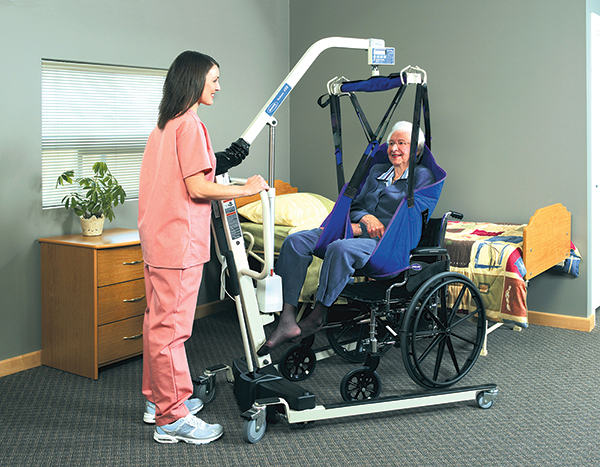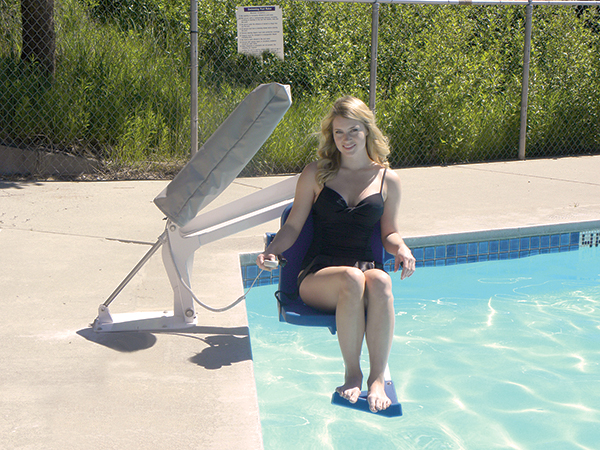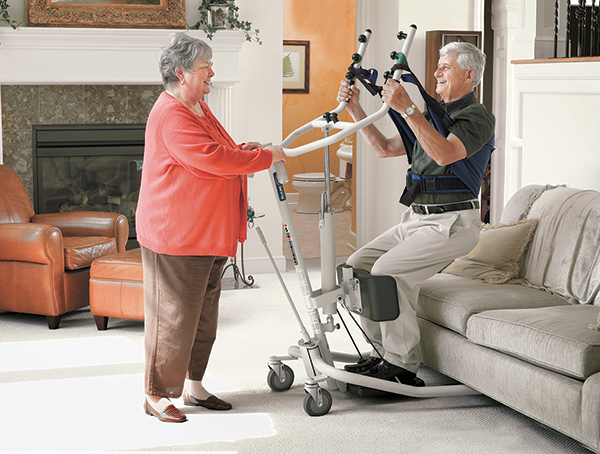The most successful providers in the patient lift market are local experts who develop the practice and employment of a high-engagement service model. They cultivate consulting relationships in many aspects of the industry to reduce caregiver injuries, prevent patient falls and create specialized solutions, with a view toward better clinical outcomes.
Invacare’s Brian Schaff, business manager, HME safe patient handling, foresees continuing long-term pressure on reimbursement rates as the government and industry seek to contain health care costs. On a positive note, patient lifts are not impacted by competitive bidding, and Medicare increased reimbursement rates about 0.8 percent in 2013.
Invacare recommends that providers ensure that their business portfolio is well diversified. “Becoming an expert in safe patient handling requires a broad base of revenue sources in acute care, long-term care, managed care, Medicare/Medicaid and private payers,” says Schaff. “Understanding the caregiver’s requirements and tailoring recommendations to their specific needs will produce better outcomes for providers and end-users.”
Hans Sigvardsson, president of Handicare USA, says more affluent customers choose to pay cash for devices. Third-party-pay business may be due to a life-changing event, such as an accident, that causes someone to require a particular type of device. He sees continuing reinforcement of a trend toward simpler patient lift products that are becoming stronger and offering more choice in colors and models. He says providers can depend on Handicare to keep a wide variety of product inventory ready to ship.
Sigvardsson advises HME providers to start with a limited product selection in a specific area, and grow the business from there. It all depends on the HME provider’s skill set, especially relating to installation of stair lifts, ceiling lifts and other complex products. “It’s better to do one thing well rather than 100 things poorly,” he says.

Lighter, Portable Products
Trends in patient lifts include greater portability, lighter devices and stronger reliability as a result of the use of new materials and advanced technology, says David Lykins, managing partner, Amica Medical Supply, which handles the operation of the patientliftusa.com and amicamedicalsupply.com websites. Most importantly, patient comfort and safety have improved greatly. Lykins notes also that lifts are now being designed for use by a single caregiver rather than two. The lifts have tapered legs and oversize handles to allow for easier control of a patient. Electric patient lifts have hand pendants that allow the operator to perform the lift. For some models, the opening of the lift’s base—with just a touch of a button—allows greater control and caretaker contact with the patient during the lifting process, which can be unsettling to many patients.
Safety is a big concern, and patient lifts offer a manual lowering process in the event the battery or motor fails, Lykins adds. Lifts also have low-battery alarms, and batteries can now be removed from the lift unit to be charged in a docking station, which eliminates the need to plug a lift directly into the wall. Two batteries that come standard with some units ensure there is always a charged battery available and ready for use.
Amica Medical Supply began in 2010 as Patient Lift USA, and the Internet retailer has since expanded its business beyond patient lifts into nine other categories including home care beds and mobility. The dealer’s expansive range of patient lifts includes electric Hoyer lifts, stand-up lifts, electric and manual lifts, bariatric lifts (600 pounds or more), bath lifts and ADA-compliant pool lifts.
The original patientliftusa.com web-site sells to individuals for home care applications and to care facilities. A “lift matrix” on the site is a guide that shows the key specs of the various available patient lift models at a glance.
Among the products at patientliftusa.com is the Hoyer Advanted-E electronic lift by Joerns, which is also available in a manual hydraulic version. At a lightweight 69 pounds, the lift is portable and easy to store, and can be assembled in a couple minutes—with no tools required.
This patient lift is also unique in that it is specially designed to help patients get in and out of their vehicles. Lykins also mentions the U-Sling, which is easier to put on and to remove, using a “between the legs, criss-cross” design rather than the hammock-like approach of a full-body sling. The site also offers brands such as Invacare, Medline, Lumex (made by Graham-Field) and Drive Medical.
Lykins emphasizes the need for product knowledge and training. “The majority of people who call us don’t know what they want,” he said. “Maybe they saw a lift at a retirement home or a doctor tells them about it. It’s our job to explain how they work.” Amica Medical Supply offers its customers buying guides—Lifts 101 and Slings 101—and videos. “The majority of customers do need a little hand-holding,” he says. The website prominently lists a phone number to call for information.
Many who buy directly from the website are repeat customers or knowledgeable professionals, says Lykins. The website accepts credit card, certified or personal check or financing through PayPal. Amica Medical Supply works with customers to provide requested documentation for pursuing reimbursement from Medicare or private insurance but does not process claims.

Training to Ensure Safety
Patient lift manufacturers emphasize the need for safety and training. HME providers offering Handicare products must be certified and trained to install products to minimize liability issues. “Safety for clients who use the products is very important,” says Sigvardsson. “If something happens to a client at home, everyone will be sued.”
For Handicare’s non-installable products, training needs vary based on the product—some products are intuitive and others, such as floor lifts, are more complex. The company supplies videos to help, and every product comes with an instruction guide and brochure, with additional information easily accessed on the Internet.
Handicare USA has a broad line of accessibility products, from stairlifts to vertical platform lifts, for inside and outside. Handicare’s patient handling systems enable caregivers and families to assist a home care patient who is not totally mobile, from the bed to a chair, from a chair to a toilet, etc.
The company also offers floor and ceiling lifts and bathroom safety products such as grab bars and shower chairs. Handicare works with a range of HME providers, some offering home modification construction services, some selling non-installable products, and others selling both.
Another major supplier, Invacare, monitors feedback from providers to guide development of advanced features that protect caregivers, while improving clinical and financial outcomes. As medical care shifts from acute care in nursing facilities into the home, caregivers need products that are easy to operate in tight spaces, says Schaff of Invacare.
The company offers a comprehensive portfolio of safe patient lifting equipment, from manual to power-operated lifts, including full-body floor lifts, sit-to-stand floor lifts and a range of slings to improve comfort and fit.
The Invacare I-Lift Series of power floor lifts, just introduced in August, provides maneuverability and ease of use. The lifts operate in tight spaces with a low base clearance, small turning radius and low-friction casters that require 60 percent less force to push.
For ease of use, the I-Lift Series features a slim, lightweight and ergonomic hand pendant with simple symbols. The lifts come with two 24v batteries and a remote charging station so one battery can charge while the other is in use.
Flexibility Key to Effectiveness
Other new products are also emerging in the patient lifts segment this fall. Shoprider USA introduces the Barton Patient Transfer System at Medtrade in Orlando, which can move a patient with a single attendant from a bed to a chair.
The device positions the patient for increased circulation and reduced issues from lying down. It folds into a gurney or into a chair position then into a chair position with a recliner. The product is reimbursed by Medicare as an E1035 multi-positional patient transfer system, not subject to competitive bidding.
Flexibility is also and important issue when it comes to lifting options. SureHands Lift and Care Systems addresses the need for customization by meeting patient handling needs in the home care environment with products that are designed to be used long-term—some for more than 15 years.
Offering lift product options including ceiling lift, wall lift, mobile lift or even a specially designed lift for the pool can help customers address varying transfer goals, according to SureHands.

Lifts for Pools and Spas
Lifts built specifically for pools and spas can enable access for home care patients to benefit from aquatic therapy. Aqua Creek Products has been manufacturing pool and spa lifts for 10 years, offering more than one dozen choices from inexpensive sling models that require caregiver assistance to fully automatic ADA-compliant lifts for commercial use.
The company’s flagship model, the Original Pro Pool Lift, has a compact, low-profile design and a 450-pound weight capacity. Dual flip-up arms enable easy lateral transfers, and simple out-and-down operation eliminates additional rotating parts. Optional accessories can turn the lift into an aquatic cycle for in-water therapy and exercise.
Although Aqua Creek’s main focus has been on commercial, ADA-compliant lifts, marketing manager Michelle Bissonnette is seeing more and more lifts ending up in homes.
Common requests include requests such as heavier weight capacities, custom seat heights, wider seat options and aquatic exercise attachments. “As awareness increases and our products see more widespread use, we expect to see many more requests for features and customizations,” says Bissonnette.
Dealers should provide feedback to manufactures to help them improve their products, she adds. “Aqua Creek thrives on building synergy with our dealers.”
Pool lifts are simple to operate, maintain and service. Most of Aqua Creek’s lifts use 24v rechargeable batteries. Lift repairs involve simple plug-and-replace components. Bissonnette says not every pool lift will work with every pool or spa—there are requirements and limitations depending on design.
Use of a pool lift will also require the installation of a pool deck anchor system. Safety is paramount, and Aqua Creek recommends installation by a contractor familiar with pool equipment.
Providers should know the products they sell inside and out, comments Bissonnette. They should also know their customers’ needs and consider their abilities. If you decide to carry a large item such as a pool lift, you should be prepared to handle to volume of questions that come along with offering the product. Be prepared to answer questions about every option available from the line(s) you are considering bringing into your store. “Do some research before bringing on a line of pool and spa lifts and choose on reputation and quality followed by price,” she observes.
Although there are several option of lift lines available to providers, you want to offer your customer the best. Consider quality and ease of use, in addition to price alone. It can be tempting to go with the least expensive option, but according to Bissonnette, a provider must weigh all of the options and, “Don’t always put price first.”
